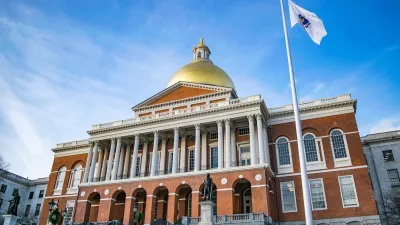In need of an underground overhaul, the Capital Beltway exemplifies the deteriorating conditions of 1/3 of the nation's roadways.
The Capital Beltway, like many of the nation's roads built more than 50 years ago, is in a state of invisible disrepair. Beyond just a surface facelift, it needs underground repairs, which would require tearing out several lanes at once and working during night hours to avoid rush hour traffic. Nearly 2/3 of the Beltway's 64 miles are in Maryland, which recently passed a transportation bill.
According to the American Society of Civil Engineers, the U.S. needs to spend an average of $250 more per person per year to provide long-term fixes to the nation's crumbling roadways, nearly a third of which need immediate attention.
To make up for the federal government's foray into austerity, states have adopted transportation plans that include gas and sales tax increases. They will need to triple transportation spending in order to bring roads up to date, writes Ashley Halsey III.
But is repairing the tens of thousands of roadways nearing the end of their life spans the best use of increasingly scarce transportation funds?
FULL STORY: Beneath the Surface, the Beltway Crumbles

Study: Maui’s Plan to Convert Vacation Rentals to Long-Term Housing Could Cause Nearly $1 Billion Economic Loss
The plan would reduce visitor accommodation by 25,% resulting in 1,900 jobs lost.

North Texas Transit Leaders Tout Benefits of TOD for Growing Region
At a summit focused on transit-oriented development, policymakers discussed how North Texas’ expanded light rail system can serve as a tool for economic growth.

Why Should We Subsidize Public Transportation?
Many public transit agencies face financial stress due to rising costs, declining fare revenue, and declining subsidies. Transit advocates must provide a strong business case for increasing public transit funding.

How to Make US Trains Faster
Changes to boarding platforms and a switch to electric trains could improve U.S. passenger rail service without the added cost of high-speed rail.

Columbia’s Revitalized ‘Loop’ Is a Hub for Local Entrepreneurs
A focus on small businesses is helping a commercial corridor in Columbia, Missouri thrive.

Invasive Insect Threatens Minnesota’s Ash Forests
The Emerald Ash Borer is a rapidly spreading invasive pest threatening Minnesota’s ash trees, and homeowners are encouraged to plant diverse replacement species, avoid moving ash firewood, and monitor for signs of infestation.
Urban Design for Planners 1: Software Tools
This six-course series explores essential urban design concepts using open source software and equips planners with the tools they need to participate fully in the urban design process.
Planning for Universal Design
Learn the tools for implementing Universal Design in planning regulations.
City of Santa Clarita
Ascent Environmental
Institute for Housing and Urban Development Studies (IHS)
City of Grandview
Harvard GSD Executive Education
Toledo-Lucas County Plan Commissions
Salt Lake City
NYU Wagner Graduate School of Public Service



























